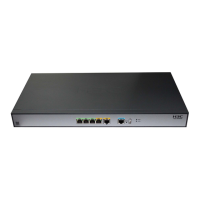10
When a wireless client operates, it periodically searches for (scans) surrounding wireless
networks. During active scanning, the wireless client actively sends probe request frames and
obtains network signals from received probe response frames. Active scanning includes two
modes according to whether a specified SSID is carried in a probe request.
{ A client sends a probe request (with the SSID null, or, the SSID IE length is 0)—The
client periodically sends a probe request frame on each of its supported channels to scan
wireless networks. APs that receive the probe request send a probe response, which
carries the available wireless network information. The client associates with the AP with
the strongest signal. The active scanning mode enables a client to actively get acquainted
with the available wireless services and to access the proper wireless network as needed.
The active scanning process of a wireless client is as shown in Figure 2.
Figure 2
Active scanning (the SSID of the probe request is null or no SSID
information is carried)
{ A client sends a probe request (with a specified SSID)—When the wireless client is
configured to access a specific wireless network or has already successfully accessed a
wireless network, the client periodically sends a probe request carrying the specified SSID
of the configured or connected wireless network. When an AP that can provide the wireless
service with the specified SSID receives the probe request, it sends a probe response. This
active scanning mode enables a client to access a specified wireless network. The active
scanning process is as shown in Figure 3.
Figure 3
Active scanning (the probe request carries the specified SSID AP 1)
2. Passive scanning
Passive scanning is used by clients to discover surrounding wireless networks through listening
to the beacon frames periodically sent by an AP. All APs providing wireless services
periodically send beacons frames, so that wireless clients can periodically listen to beacon
frames on the supported channels to get information about surrounding wireless networks and
connect to an AP. Passive scanning is used by a client when it wants to save battery power.
Typically, VoIP clients adopt the passive scanning mode. The passive scanning process is as
shown in Figure 4.
Pr
ob
e
r
e
q
u
es
t
(
w
i
t
h
n
o
SSI
D
)
Pr
ob
e
r
e
q
ue
s
t
(
w
i
t
h
n
o
SSI
D
)
Pr
o
b
e
R
e
s
p
on
s
e
Pr
o
b
e
R
e
s
p
o
ns
e

